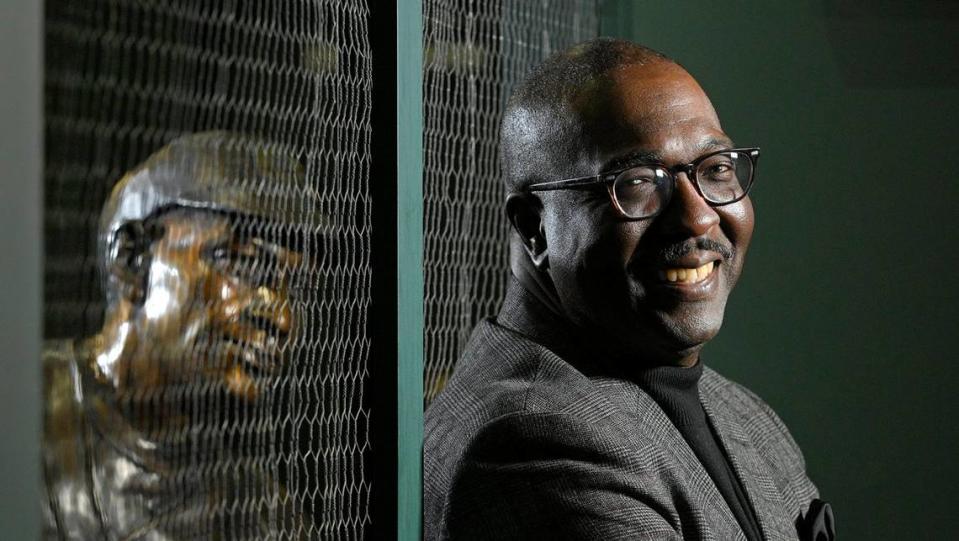Negro Leagues stats finally crack MLB’s record book. But don’t get lost in the numbers
A chicken-wire fence provides an introduction to a tour through the Negro Leagues Baseball Museum in Kansas City, and the facility’s president and guide, Bob Kendrick, uses it both literally and metaphorically.
It symbolically separates visitors from the bronze statues comprising the Field of Legends, and Kendrick twists his fingers into the fence as his opening monologue begins maybe five feet from a statue of catcher Josh Gibson.
“The truth,” Kendrick refers to him.
Five years ago, he allowed me to tag along for more than a half-dozen of these jaunts through the museum, with present-day major-league players the intended audience. That’s where his tours always begin, and thus too where my story began.
His description of Gibson felt fitting then.
Fitting now, too.
Major League Baseball announced plans to blend Negro Leagues statistics into its record book, and no player’s proverbial on-paper resume will benefit more than Gibson, who now owns a handful of them, most notably career and single-season average.
“It gives me a little fuel,” Kendrick says, “in some of these stories that I get to share.”

It’s a pretty cool development — and, man, bless those who spent more than three years (and counting) digging through newspapers and other relics in search of the box scores to make it happen. Truly commendable work.
For the rest of us: Debating how those statistics will now fit or, worse, how they should fit, into baseball’s history is missing the point.
The story of Negro Leagues has never been about the numbers.
Not then.
Still not today.
It’s about the story. Or stories, I should say, because Kendrick never seems to run out of them. And this is yet another step to offering them a wider audience.
A man better suited for his place of employment than anyone you will meet, Kendrick rekindles the history of the Negro Leagues to anyone willing to listen — to players past and present, to civil rights leaders or to John and Jane from down the block. In a tour setting, he is a one-man show who entertains as he educates, the inspiration of Buck O’Neil who brings to life a century-old tale.
A tale that he shares, notably, with hardly a mention of any numbers.
“I didn’t care about the stats,” Kendrick says. “I don’t want to make it sound so cold, but I just know you cannot reduce this story to statistics.”
That is not an accusation against the latest development, for which, to be abundantly clear, Kendrick is grateful. A watershed moment, he called the statistics’ inclusion during a news conference on Wednesday. Significant, as he said more than once.
But that’s not because anyone required some sort of validation for Gibson’s power and average combination, or for Satchel Paige’s season in which his earned run average hovered just above 1.00, or for a league that supplied the first home for so many of baseball’s all-time greats. Those players don’t need the validation of a league that deprived them of it for so long.
But the opportunity it represents? It is a vessel to once more spread the word of the Negro Leagues.
The museum represents the league’s place in American history — its place in helping to change American history.
That’s what this day symbolizes.
That history.
And a new audience for it.
“This is the story of America at her worst,” Kendrick says, “but it’s also the story of American at her triumphant best.”
The framework for the league originated here in Kansas City, when Black baseball team owners met at a YMCA in February 1920. It originated first out of necessity, not from first choice.
Twenty-seven years passed before Jackson Robinson broke baseball’s self-imposed color barrier.
“While America was trying to prevent them from sharing the joys of her so-called national pastime, it was the American spirit that allowed them to persevere and prevail,” Kendrick says. “What’s not to love about that kind of story?”
What’s to love now: A few more people will probably hear it — and a few of those probably need to hear it.
The reason for its origin is shameful, but the narrative of the league itself is not a somber one. The Negro Leaguers played with speed and flare. With showmanship. With trash talk, even, friendly or perhaps otherwise.
With, well, an impact on those today.
“It’s kind of hereditary,” former player Dee Gordon once told me after walking through the exhibits.
See, the Negro Leagues have long been blended into Major League Baseball, even if their official statistics were not until this week.
The statistical integration will provide that fact a louder voice now, though if you think it comes at the expense of apples-and-oranges comparisons because of small sample sizes, make sure you note this: Those players played under a type of pressure their counterparts did not.
They traveled to cities that did not serve them meals, packing peanut butter and crackers into lunch pales in case it was all they could eat. They did not know if they’d find a place to shower. They did know they’d have to play back-to-back games without washing their uniforms.
That’s the perseverance behind the numbers.
It’s what the museum has been sharing for three decades now.
In 1993, Kendrick first met O’Neill, the former Kansas City Monarchs player who made Kansas City his home and helped to make the Negro Leagues Baseball Museum the home for so many more. At the time, Kendrick wondered out loud, what was his primary motivation for wanting to build a museum?
Easy, O’Neil said.
“So that we would be remembered.”
Not simply for their play.
But for their impact.

 Yahoo Sports
Yahoo Sports 
